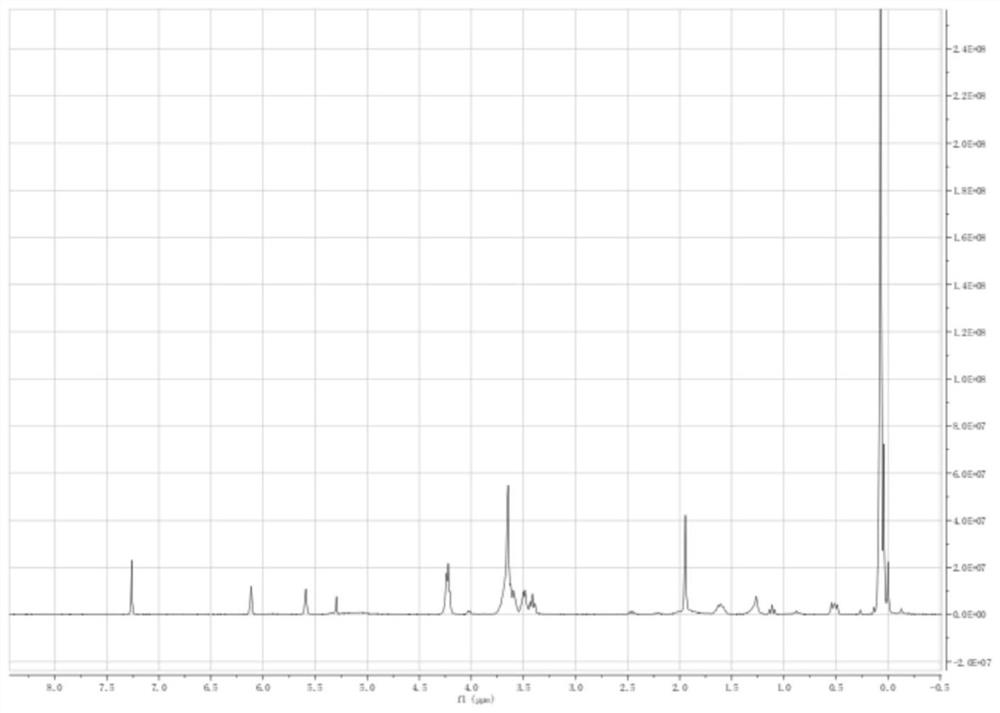Silicone hydrogel with high oxygen permeability, corneal contact lens and preparation method of corneal contact lens
A silicon hydrogel and silicon monomer technology, applied in glasses/goggles, instruments, optics, etc., can solve problems such as poor compatibility, damage to the network structure, and limited oxygen permeability of materials
- Summary
- Abstract
- Description
- Claims
- Application Information
AI Technical Summary
Problems solved by technology
Method used
Image
Examples
Embodiment 1
[0097] Preparation of Monoblocked Organosiloxane Macromonomer
[0098] Take 30 g of HO-PDMS (the number average molecular weight is about 1500, where m is about 7 and n is about 16, purchased from Nanjing Fuqun Chemical Co., Ltd.), and 50 mL of dichloromethane (CH 2 Cl 2 ) and 0.1g dibutyltin dilaurate, stir and mix well. Then weigh the corresponding proportion of IEM and CH 2 Cl 2 Mix, add constant pressure dropping funnel, add IEM and CH to the reaction solution dropwise 2 Cl 2 Mixture. At the same time, turn on the constant temperature water bath heating device, adjust the temperature to 55° C., and react for 10 h. After the reaction was completed, it was rotated at 50° C. for 30 minutes to obtain a single-terminated organosiloxane macromonomer, which was denoted as M1-w1. figure 1 It is the NMR spectrum of the single-terminated organosiloxane macromer (M1-w1) prepared in Example 1.
[0099]
[0100] Among them, m is about 7, n is about 16
[0101] (M1-w1)
Embodiment 2
[0103] Preparation of Monoblocked Organosiloxane Macromonomer
[0104] Take 50 g of HO-PDMS (the number average molecular weight is about 5500, where m is about 11 and n is about 50, purchased from Nanjing Fuqun Chemical Co., Ltd.), and 80 mL of CH 2 Cl 2 and 0.2g dibutyltin dilaurate, stir and mix evenly. Then weigh the corresponding proportion of IEM and CH 2 Cl 2 Mix, add constant pressure dropping funnel, add IEM and CH to the reaction solution dropwise 2 Cl 2 Mixture. At the same time, turn on the constant-temperature water bath heating device, adjust the temperature to 55°C, and react for 10 hours. After the reaction is completed, rotate steam at 50°C for 30 minutes to obtain a single-terminated organosiloxane macromonomer, which is designated as M1-w2. figure 2 It is the NMR spectrum of the single-terminated organosiloxane macromer (M1-w2) prepared in Example 2.
[0105]
[0106] Among them, m is about 11, n is about 50
[0107] (M1-w2)
Embodiment 3
[0109] Preparation of double-capped organosiloxane macromonomer
[0110] Take 13g of diol (the structural formula is shown in the following formula W3), 20mL of chloroform, 0.1g of catalyst dibutyltin dilaurate, 1.2g of isocyanate methacrylate (IEM), mix well, and heat to reflux at 50°C for 10h. After the reaction, wash with petroleum ether, let stand to separate layers, take the lower layer and distill under reduced pressure to obtain a transparent double-capped organosiloxane macromer (Formula II), which is denoted as M2-W3.
[0111]
PUM
| Property | Measurement | Unit |
|---|---|---|
| elongation at break | aaaaa | aaaaa |
Abstract
Description
Claims
Application Information
 Login to View More
Login to View More - R&D
- Intellectual Property
- Life Sciences
- Materials
- Tech Scout
- Unparalleled Data Quality
- Higher Quality Content
- 60% Fewer Hallucinations
Browse by: Latest US Patents, China's latest patents, Technical Efficacy Thesaurus, Application Domain, Technology Topic, Popular Technical Reports.
© 2025 PatSnap. All rights reserved.Legal|Privacy policy|Modern Slavery Act Transparency Statement|Sitemap|About US| Contact US: help@patsnap.com



